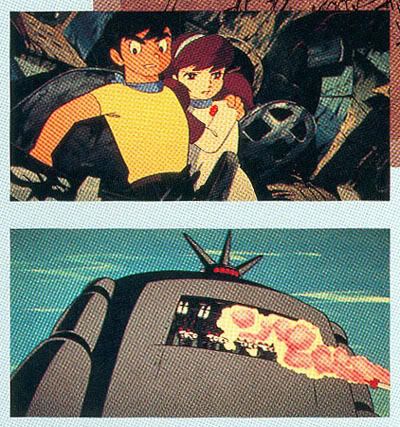
We are speaking, of course, of a film that features a giant flying derelict sailing ship, captained by a ghostly apparition in a skull mask, which is actually a super-scientific aerial battlewagon equipped with lasers and missiles. Its mission is to defeat an international conspiracy which defies mankind with giant robots, enormous talking crabs, and a popular, addictive soft drink that eventually dissolves you into mush. Our hero, the boy Hayato (assisted by his loyal dog) is tragically orphaned in the midst of a worldwide crisis. Rush-hour Tokyo is interrupted by Self-Defense Force tanks manuvering to attack an enormous rocket-firing robot Golem bent on smashing the city to bits. Hayato reels as he uncovers the awful truth behind his millionaire benefactor, and his attempt to warn the world is halted by the invasion of enormous crusteaceans. He eventually learns the secret behind his true parentage and finds himself captaining a super scientific undersea battleship on a kamikaze mission to the bottom of the ocean. Most other films would get away with one or maybe two of those concepts. Not FLYING PHANTOM SHIP, which cheerfully shoehorns enough insanity for eight or nine movies into its sixty minutes.

Is it deep? No. Did it win awards from parents groups or arts councils? No sir. If you mention it in film class, will the other students be impressed? I wouldn't try it. But does it satisfy 1000% percent of your daily recommended allowance of FUCKING AWESOME - the whole reason you watch these darn Japa-heeno cartoons anyway? Yes. Yes it does.
Based on a 1960 SHONEN MAGAZINE story by legendary manga-ka Shotaro Ishinomori, it might have seen an odd choice to film, but Toei had had earlier success with Ishinomori's CYBORG 009 film and TV series, full of the same sort of super-science action. Toei would later release another Ishinomori-based short film - 30,000 MILES UNDER THE SEA, another aquatic-themed SF movie - and while a unique and entertaining film, it's no FLYING PHANTOM SHIP.

If this doesn't push your buttons, you need to go to the doctor and get your buttons checked out. FLYING PHANTOM SHIP is pure distilled cartoon excitement delivered with the slick 60s style of your favorite period spy films or sci-fi TV shows. It was a hour-long reminder of the outlandish cartoon fun that made me love Japanese cartoons to begin with, and I found it in 1990, when my interest in the media was at an all-time low. Apart from the occasional Miyazaki film and the cerebral musings of Patlabor, the early 90s were a moribund time of weak, derivative OVAs and limp sequels sucking the life out of once-powerful franchises. In this muddled environment the boldness of FLYING PHANTOM SHIP was a breath of fresh, thirty year old air.
Too nutty and violent to be "educational", FLYING PHANTOM SHIP wasn't based on a fairy tale or a storybook like many of Toei's 1960s releases. It didn't win any Parents Awards or Certificates Of Merit from Self-Important International Organizations Of Children's Cinema. What it DID do was entertain the livin' shit out of audiences, a hint of juvenile sci-fi actioners like MAZINGER Z and CAPTAIN HARLOCK that would later cement Toei's reputation as an energetic (if not overly concerned with technical brilliance) animation powerhouse.

And yet in spite of my cheerleading the film's nonsensical sugary center, FLYING PHANTOM SHIP can't help but make you think. The script's bolted-together combination of H.P. Lovecraft, Jules Verne, and Ian Fleming might ONLY work set in a postwar Japan in which the industrial giants fueling the nation's economic miracle are the same economic giants who profited from the wholesale rape of China, Korea, and the Philippines during the Pacific War. The notion that things are not what they seem, that behind the skyscrapers and advertising and rock and roll of boom-time Japan lurk horrifying monsters, provides the film's subtextual center. The film's message - that those who claim to be fighting the menace are actually CAUSING the menace for their own evil ends - is a hallmark of paranoid screeds stapled to telephone poles or posted on the Internets throughout the world. And Hayato's futile attempt to warn the world- via cheerfully hosted TV chat show- puts a media-saturated spin on every child's nightmare of Not Being Listened To.

The big-eye Ishinomori character designs are sometimes at odds with the more naturalistic animation, particularly the tanks-in-Tokyo scene that Miyazaki would later use for a Lupin III television episode. There's a real effort made at realism in portrayals of the city, the military equipment, and your nautical spars and yardarms, right down to the undersea flora and fauna that the Flying Phantom Ship moves through. Yet director Hiroshi Ikeda's primary-colored, full-animation style makes it a very 60s-looking movie, kind of a throwback, and a surprising choice for a 1969 animated release. However, the apocalyptic, paranoid tone fits right in with the adult films of the period. The nervous undercurrents, jammed up against typical children's adventure movie cliches like Comedy Relief Dog, Tacked On Girlfriend, and Guess Who Your Real Dad Is, make it hard to tell whether this is a really dark kids movie, or the first attempt at an anime film aimed at older audiences, the kind that would dominate the field in the 70s and 80s. Perhaps it's both.

My fanzine article about FLYING PHANTOM SHIP from 18 years ago. I'm old.
Ignored for years by anime fandom, FLYING PHANTOM SHIP is needed now, more than ever, to remind the world why we got into this stuff in the first place; that sense of outlandish did-I-just-see-that nonsense that engages the big kid in us all. At the end of the day don't we all want to be Captain Hayato, master of his own vessel, sailing into a bright future? Go ahead Captain Hayato!!



